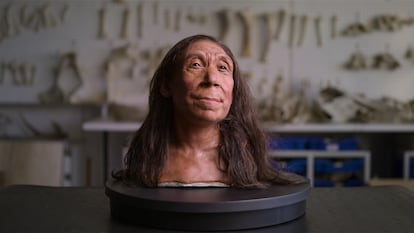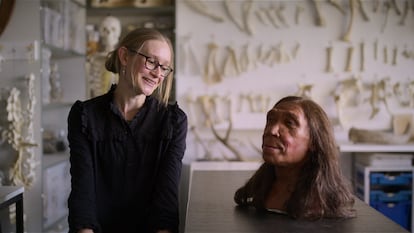Why Netflix’s idealization of a Neanderthal woman is a problem
Her name is Shanidar Z. She has a calm and considered expression that is a far cry from the snarling, animalistic stereotype of the Neanderthal

From a flaky skull, found “as flat as a pizza” on a cave floor in northern Iraq, the face of a 75,000-year-old Neanderthal woman named Shanidar Z has been reconstructed. With her calm and considered expression, Shanidar Z looks like a thoughtful, approachable, even kindly middle-aged woman. She is a far cry from the snarling, animalistic stereotype of the Neanderthal first created in 1908 after the discovery of the “old man of La Chapelle.”
On the basis of the old man and the first relatively complete skeleton of its kind to be found, scientists made a series of presumptions about Neanderthal character. They believed Neanderthals to have a low, receding forehead, protruding midface and heavy brow representing a baseness and stupidity found among “lower races.” These presumptions were influenced by prevailing ideas about the scientific measurement of skulls and racial hierarchy — ideas now debunked as racist.
This reconstruction set the scene for understanding Neanderthals for decades, and indicated how far modern humans had come. By contrast, this newest facial reconstruction, based on research at the University of Cambridge, invites us to empathize and see the story of Neanderthals as part of a broader human history.
“I think she can help us connect with who they were,” said paleoarchaeologist Emma Pomeroy, a member of the Cambridge team behind the research, while speaking in a new Netflix documentary, Secrets of the Neanderthals. The documentary delves into the mysteries surrounding the Neanderthals and what their fossil record tells us about their lives and disappearance.
It was not paleoanthropologists, however, who created Shanidar Z but well-known paleoartists Kennis and Kennis, who sculpted a modern human face with a recognizable sensibility and expressions. This drive towards historical facial reconstruction, which invokes emotional connection, is increasingly commonplace through 3D technologies and will become more so with generative AI.
As a historian of emotion and the human face, I can tell you there is more art than science at work here. Indeed, it is good art, but questionable history.
Technologies like DNA testing, 3D scans and CT imaging help artists to generate faces like Shanidar Z’s, creating a naturalistic and accessible way of viewing people from the past. But we should not underestimate the importance of subjective and creative interpretation, and how it draws on contemporary presumptions, as well as informing them.
Faces are a product of culture and environment as much as skeletal structure, and Shanidar Z’s face is largely based on guesswork. It is true that we can assert from the shape of the bones and a heavy brow, for instance, that an individual had a pronounced forehead or other baseline facial structures. But there’s no “scientific” evidence about how that person’s facial muscles, nerves and fibers overlaid skeletal remains.
Kennis and Kennis have attested to this themselves in an interview with The Guardian in 2018 about their practice. “There are some things the skull can’t tell you,” admits Adrie Kennis. “You never know how much fat someone had around their eyes, or the thickness of the lips, or the exact position and shape of the nostrils.”
It’s an enormous imaginative and creative work to invent the skin color, forehead lines or half-smile. All these features suggest friendliness, accessibility, approachability — qualities defining modern emotional communication. “If we have to make a reconstruction,” Adrie Kennis explained, “we always want it to be a fascinating one, not some dull white dummy that’s just come out of the shower.”

Overlaying skeletal remains with modern affect reasserts the recent re-envisioning of Neanderthals as “just like us” rather than club-wielding thugs.
Only in the past 20 years have Neanderthals been discovered to share modern human DNA, coinciding with the discovery of many similarities over differences. For instance, burial practices, caring of the sick and a love of art.
This reimagining of Neanderthals is historically and politically interesting because it draws on contemporary ideas about race and identity. But also because it recasts the popular narrative of human evolution in a way that prioritizes human creativity and compassion over disruption and extinction.
The neglected history of the human face
It is creativity and imagination that determines the friendly facial expression that makes Shanidar Z sympathetic and relatable. We don’t know what kinds of facial expressions were used by or were meaningful to Neanderthals. Whether or not Neanderthals had the vocal range or hearing of modern humans is a matter of debate and would have dramatically influenced social communication through the face. None of this information can be deduced from a skull.
Facial surgeon Daniel Saleh told me about the cultural relevance of Shanidar Z: “As we age, we get crescentic creases [wrinkles] around the dimple — this changes the face — but there is no skeletal correlation to that.” Since facial expressions like smiling evolved with the need for social communication, Shanidar Z can be seen an example of overlaying contemporary ideas about soft tissue interaction on the bones, rather than revealing any scientific method.
This matters because there’s a long, problematic history of ascribing emotions, intelligence, civility and value to some faces and not others. How we represent, imagine and understand the faces of people past and present is a political, as well as social activity.
Historically, societies have made the faces of those they want to be connected to more emotionally empathetic. When cultures have determined, however, certain groups they don’t want to connect to and, in fact, want to marginalize, we have seen grotesque and inhuman ideas and depictions rise around them. Take, for example, anti-Black caricatures from the Jim Crow era in the U.S. or cartoons of Jewish people made by the Nazis.
By representing this 75,000-year-old woman as a contemplative and kindly soul who we can relate to, rather than a snarling, angry (or blank featured) cypher, we are saying more about our need to rethink the past than any concrete fact about the emotional lives of Neanderthals.
There is nothing inherently wrong with artistically imagining the past, but we need to be clear about when that happens — and what it is for. Otherwise, we ignore the complex power and meanings of the face in history, and in the present.
Fay Bound Alberti is a Professor in Modern History and UKRI Future Leaders Fellow, King’s College London.
This article was originally published in The Conversation.
Sign up for our weekly newsletter to get more English-language news coverage from EL PAÍS USA Edition
Tu suscripción se está usando en otro dispositivo
¿Quieres añadir otro usuario a tu suscripción?
Si continúas leyendo en este dispositivo, no se podrá leer en el otro.
FlechaTu suscripción se está usando en otro dispositivo y solo puedes acceder a EL PAÍS desde un dispositivo a la vez.
Si quieres compartir tu cuenta, cambia tu suscripción a la modalidad Premium, así podrás añadir otro usuario. Cada uno accederá con su propia cuenta de email, lo que os permitirá personalizar vuestra experiencia en EL PAÍS.
¿Tienes una suscripción de empresa? Accede aquí para contratar más cuentas.
En el caso de no saber quién está usando tu cuenta, te recomendamos cambiar tu contraseña aquí.
Si decides continuar compartiendo tu cuenta, este mensaje se mostrará en tu dispositivo y en el de la otra persona que está usando tu cuenta de forma indefinida, afectando a tu experiencia de lectura. Puedes consultar aquí los términos y condiciones de la suscripción digital.










































